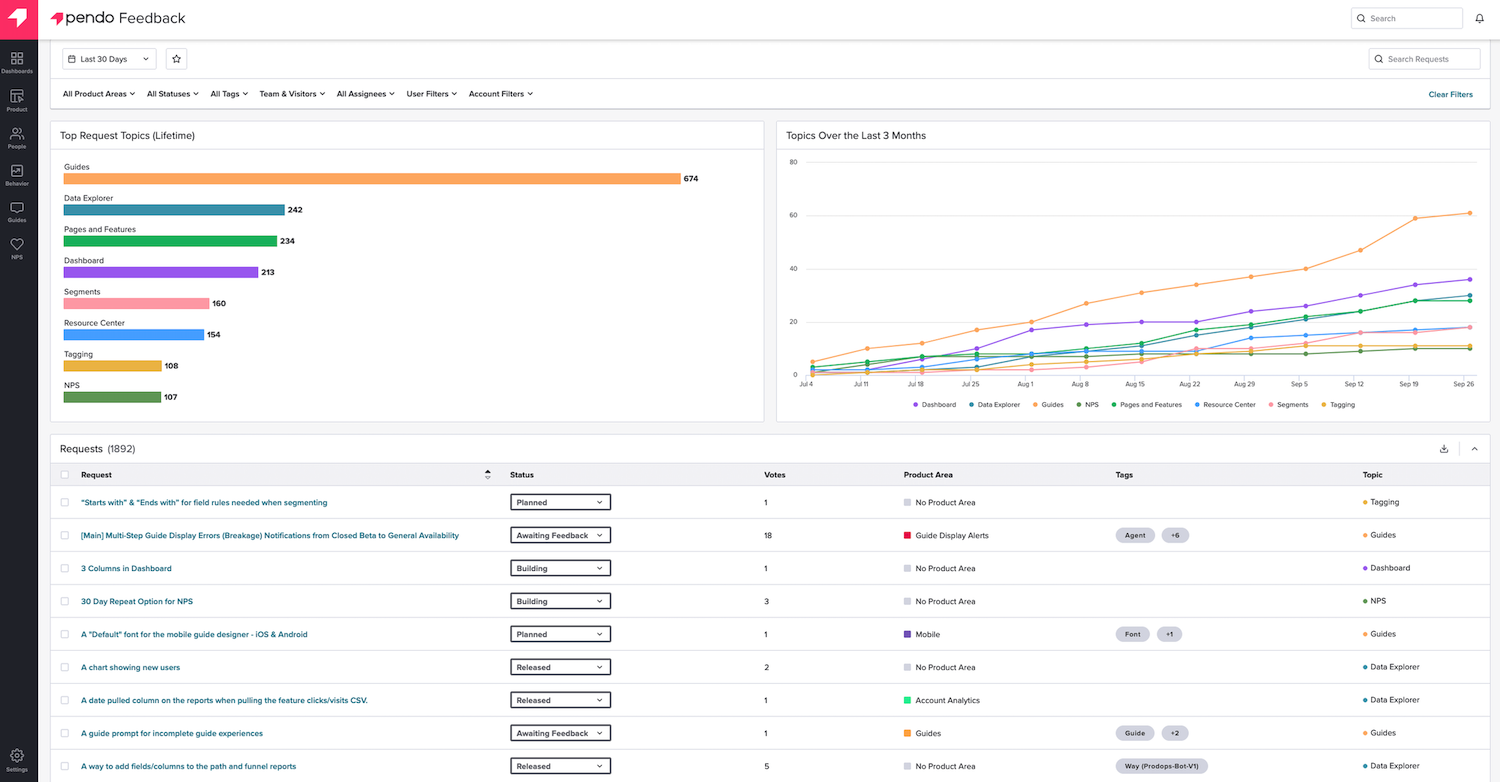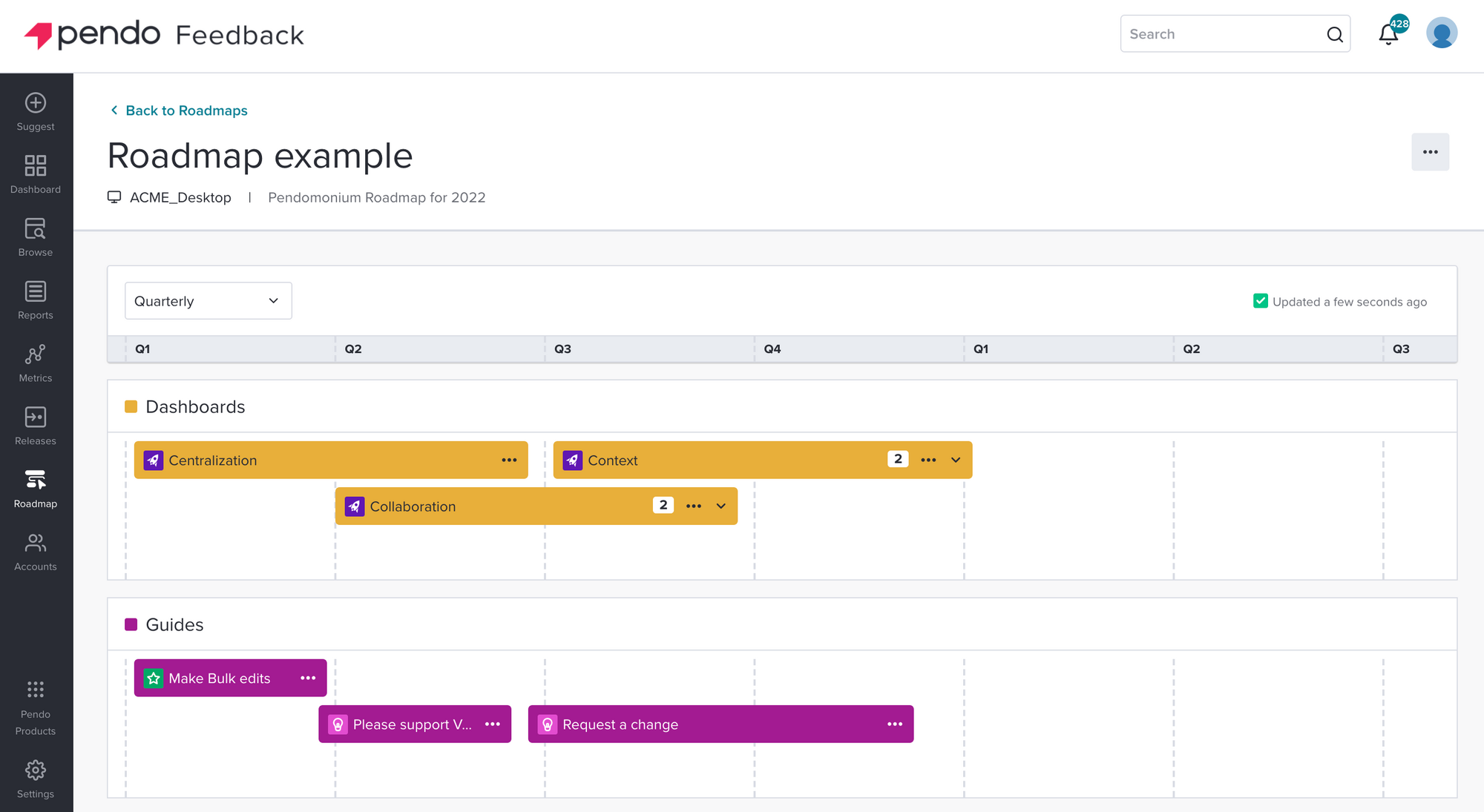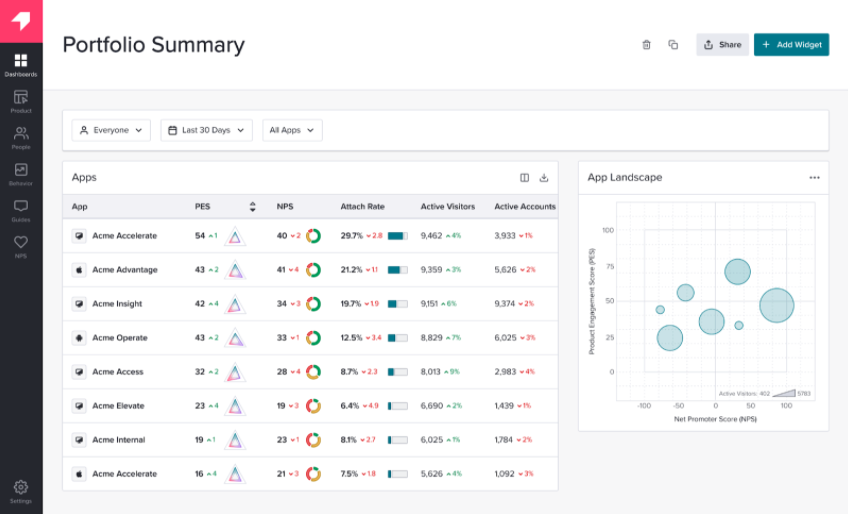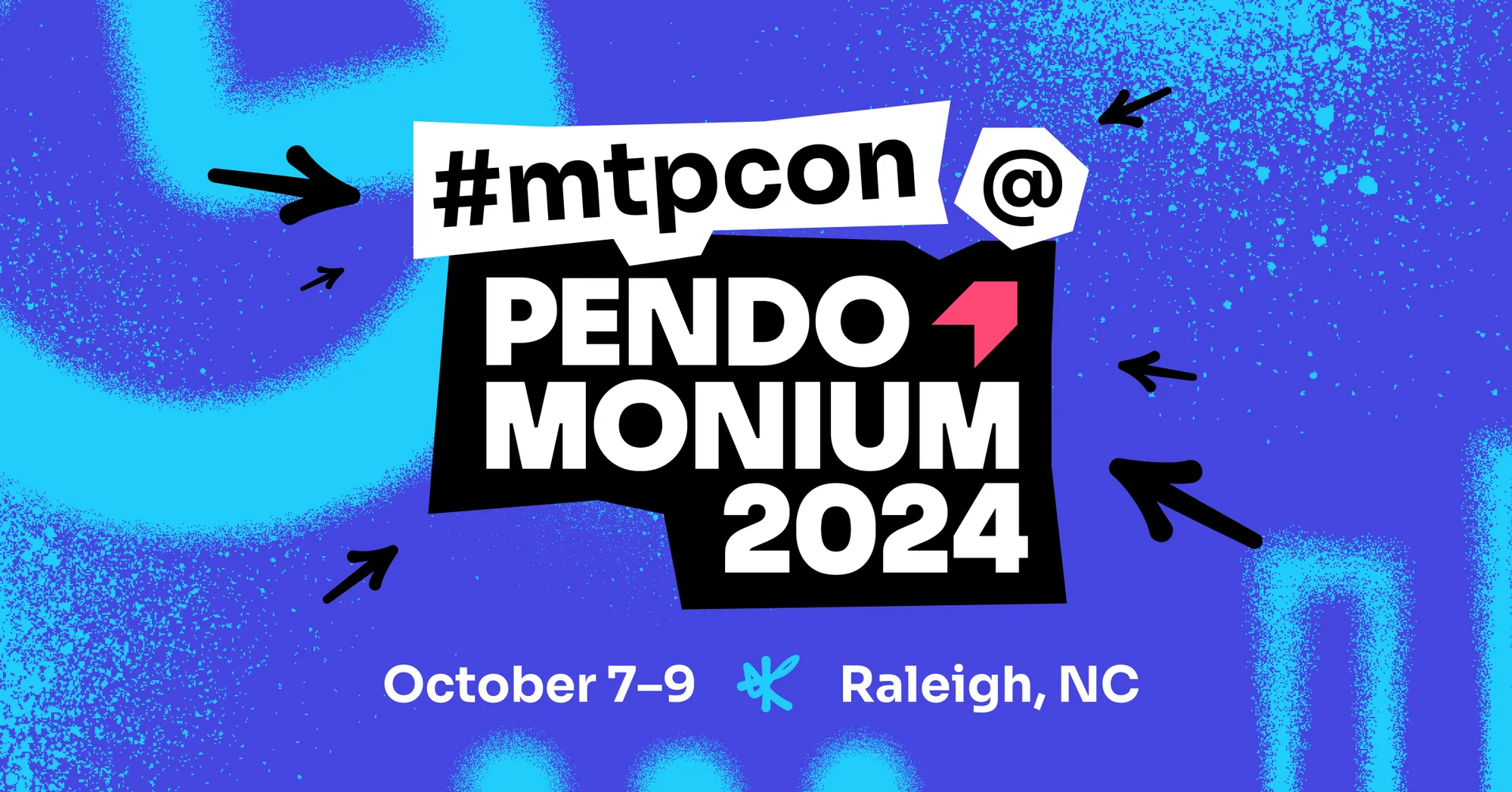Editor’s note: The Pendo Simon beta and design partner program is now closed.
On a sunny October day in Raleigh, North Carolina, Pendo brought hundreds of product-obsessed people (back) together at Pendomonium 2021 for a festival like no other.
Emerging from the doldrums of 2020, we celebrated seeing our peers and colleagues in person again (or even meeting them for the first time). We recognized the amazing work of the organizations who had to rewrite their playbooks and pivot during a year of tremendous change. And we looked forward to all the possibilities of the coming year—and the products that will get us there.
The day was packed with inspiring keynotes, informational breakout sessions, engaging partner and product activations, and interactive networking opportunities—kicked off by Pendo’s CEO and co-founder, Todd Olson.
Read on for the recap of Olson’s keynote, and scroll down to watch the full replay from the Pendomonium mainstage.
Adjusting to a new world
In 2020 almost every business you can think of—from the consumer brands you interact with every day to the lesser-known B2B organizations that power your productivity—had to find a new way to work amidst a rapidly evolving global health crisis.
Olson shared the stories of several Pendo customers who survived and thrived in the face of adversity:
- With the fitness industry facing major disruption and closures due to the COVID-19 pandemic, MindBody quickly adapted and launched a virtual wellness platform to help their customers offer classes remotely.
- Bright Horizons shifted its operations from on-site daycare to in-home childcare, launching a virtual platform to connect providers with parents and ensure continuity for kids in a work-from-home world.
- As restaurants across the country faced the harrowing reality that they might have to close their doors forever, Toast acted swiftly to help them move from a dine-in to take-out model using the Toast app.
- And in an industry that had to continue providing care despite not being able to interact directly with pet parents, PetDesk looked to the Voice of the Customer (VoC)—leveraging feedback to steer innovation and build the features veterinary practices needed most.
These stories of grit and resilience—plus the countless others we’ve seen and heard from so many of our customers—were the backbone of Olson’s remarks, and the inspiration for the innovations Pendo delivered in the last year.
How we rewrote the playbook in 2020
In the midst of unprecedented change and challenge, we looked for ways to double down and deliver new features and products to help our customers weather the storm.
In 2020, we launched Pendo Free, and have since doubled the number of companies using our free-forever product suite. In his keynote, Olson announced the introduction of Pendo Free for Mobile—a sign of our continued focus on powering product-led mobile innovation and facilitating seamless omni-channel experiences.
To support our customers’ own employees, we introduced an exciting new family of products to our portfolio called Adopt. This portfolio continues the ethos of Pendo into employee-facing applications—helping to drive adoption and create better product experiences for internal teams.
As an organization, Pendo experienced tremendous growth. We expanded our presence in EMEA by nearly 30%. We opened our first office in Asia. And we raised $150M in Series F funding to fuel continued R&D and innovation.
And finally, we continued to invest in our product-led culture. We created the product-led hub and Product-Led Organization (PLO) box—which include required reading, resources, and workshop facilitation materials to help teams everywhere become more product led. Plus, we launched How I Pendo: a curated collection of all the creative and impactful ways people are using Pendo.
As Olson noted during his keynote, “In a single year, adoption of digital products accelerated by seven years.” There’s no denying that the world is forever changed. And if we’ve learned anything from this experience, it’s that we need to stay agile and be prepared for whatever comes next.
By putting product at the center of how you operate, you can more confidently lean into the shifting landscape and deliver solutions to help your customers solve whatever challenges may come their way. In short, being product led is how you stay ready for anything.
What’s new?
Next, Olson looked forward to what’s on the horizon—and the amazing new features and innovations our customers can expect to see from Pendo in the coming months.
Separating signals from noise with Pendo Simon
We’ve heard it from our customers and seen it for ourselves: there is a lot of data out there. Pendo collects more than 12B events each day from our customers and 470M+ monthly end users. In September 2021 alone, our customers created over 11K polls and launched 77K guides—receiving 3M responses and 350M views, respectively.
And this isn’t just a Pendo phenomenon. The average app receives more than 12K pieces of customer feedback each year, with companies spending over ten hours a week working through all of it. Olson noted, “When you have more data, you have more noise.” And without an easy way to centralize and triage all that data, you’re left with qualitative information sprawl and no easy way to see the feedback forest through the anecdote trees.
This was the thesis that first drove us to develop Pendo Feedback. And now, we’re making it even more actionable with the help of our new machine learning engine, Pendo Simon.
Simon will surface the topics that are most important to your business in Pendo Feedback—parsing huge amounts of data by grouping similar ideas or requests, surfacing key customer pain points, and validating your hunches with a data-informed approach.

As Dr. Inbal Budowski-Tal (Pendo’s senior director of machine learning) stated, “Our goal is to use machine learning to make sense of lots of data by making it manageable, digestible, and easy to analyze and consume.”
Reimagining the product roadmap
The age-old question of “why are we building this?” is one many product managers typically look to their roadmap to help answer. But roadmaps don’t always tell a clear story, particularly when there isn’t an easy way to correlate what’s on your roadmap to the feedback or requests that helped shape it.
So once again, we turned to Simon for a way to augment and optimize the roadmapping process—making it more transparent, contextual, and actionable for our customers. Pendo Feedback’s new roadmapping capabilities (available in closed beta in Q4) totally reimagine the roadmapping experience, powered by topics and insights surfaced by Simon.
This new functionality allows our customers to organize their roadmap like never before, with swimlanes for each of their product areas, initiatives, features, and requests—all nested and grouped in a way that brings the context hidden within your feedback data into a centralized place.
Our new roadmapping UI brings both qualitative and quantitative insights into your roadmap, so you never have to navigate away or go digging through your VoC data to understand the “why” behind items in your roadmap. This UI also allows you to more easily spot trends and organize your initiatives into larger programs to keep your teams in sync—and ready for anything.

Revitalizing your Pendo dashboards
As a product leader, you’re well aware of the transformative power of data. But too often, data is the problem, not the solution. When your data is scattered across multiple tools and sources, it doesn’t tell a clear story and can’t be easily accessed by your team—making it harder for you to do your job.
We want to make sure Pendo helps you leverage your data to effectively solve these problems. Our newly reinvented Pendo dashboards help unite your business around a shared set of data, so you can solve problems as a team. As Stephanie Tanzar, director of product management at Pendo, said, “When data is centralized, everyone can find it. When data comes with context, everyone can get on the same page. And when data is sharable, everyone can contribute.” This is the principle behind our new Pendo Dashboards.
The Dashboard Directory allows you to de-clutter your dashboards and manage them in a single place. The Text Block widget allows you to add valuable written context to your dashboard—for example, explaining its purpose or communicating takeaways. The NPS widget allows you to understand and analyze how users feel as a team. And the Embed widget allows you to pull any iframe into your dashboard, so you can communicate more effectively and easily consolidate data sources for your team.

You can also add Guide Experiment results to your dashboard to quickly see how effective your in-app guides are. And finally, we introduced Portfolio Summary: a new view for top-level metrics for every product across your portfolio. This functionality allows you to visualize your Product Engagement Score (PES), Net Promoter Score (NPS), attach rate, active visitors, and accounts in a single pane—making the discovery process even more efficient across your product organization.
Helping employees adapt to new ways of working
Regardless of location, work now happens in software. The average enterprise company relies on over 288 individual software tools to get things done. But the software we use for work often doesn’t live up to the expectations we have for the software we use for play.
Employees deserve a better software experience; the same kind of experience companies work so hard to bring to their customers. This was the ethos behind our Pendo Adopt family of products—purpose-built to help our customers measure adoption within and across the applications they buy, then act on those findings with tools to drive increased adoption and a better user experience.
Pendo Adopt allows administrators to take a look at what employees are actually doing inside the software they use every day—like Salesforce, for example. Pendo Adopt gives you the ability to segment usage data by department, location, behavior, or any other relevant metadata; see the paths your users are taking to complete certain tasks; and understand where your users are struggling or might benefit from additional guidance. From there, Pendo Adopt makes it easy to build in-app messaging to guide your employees through workflows or serve them useful tips or information via the Resource Center—without the need for additional engineering resources.
Pendo Adopt gives employees a better, more productive product experience—while increasing adoption and maximizing the investments business leaders have made in their software.
The future of work is product led
Olson wrapped up his keynote with three reminders to help teams of all sizes become more product led:
- Separate signals from noise
- Collaborate in your own system of record
- Help your employees adopt the software required to do their jobs
And he reminded us all that as product leaders and the drivers of digital transformation, we have a critical role to play in paving the way for the future of work—and helping our organizations stay ready for anything.
Check out the full recording of Olson’s Pendomonium keynote here:




